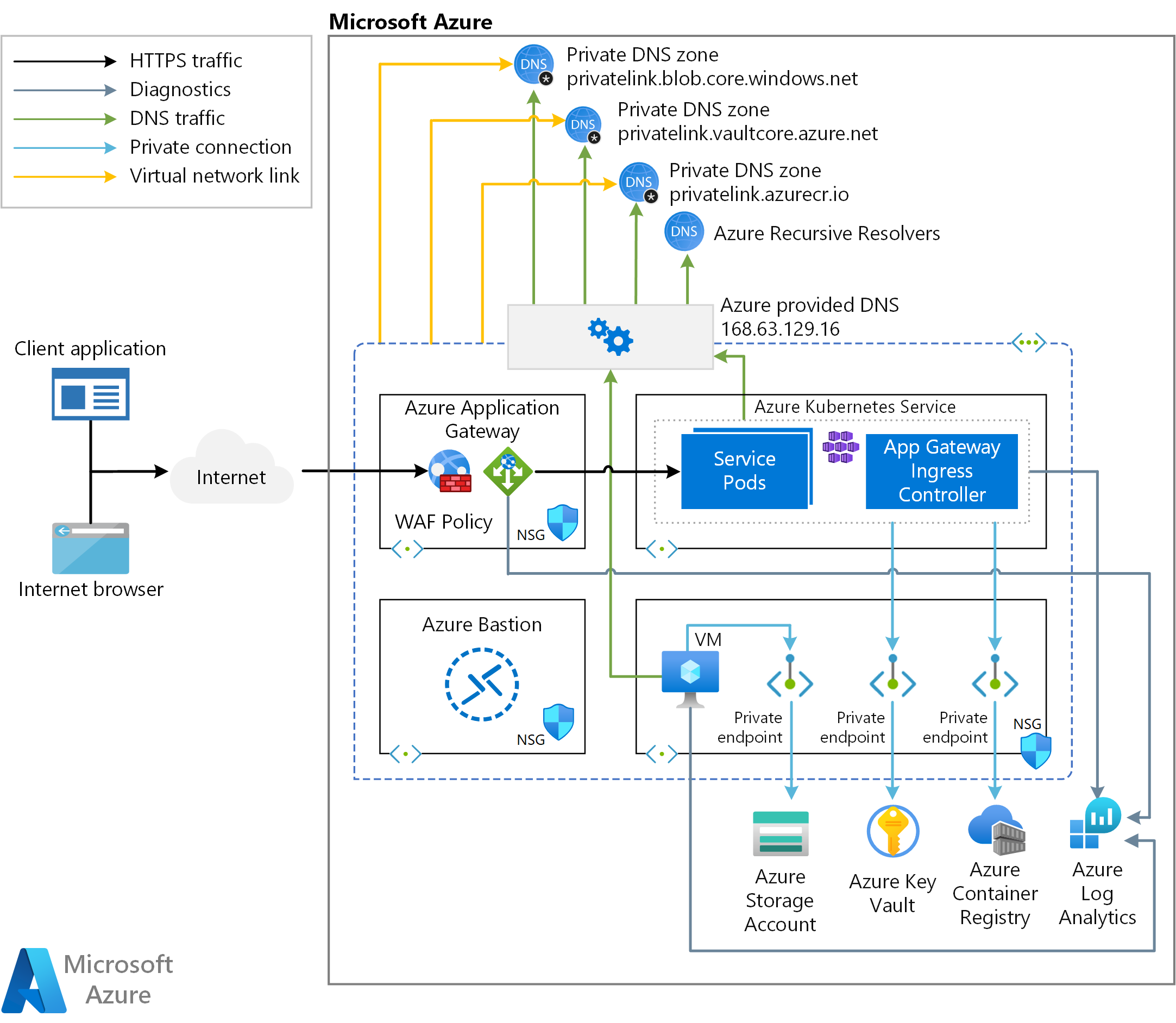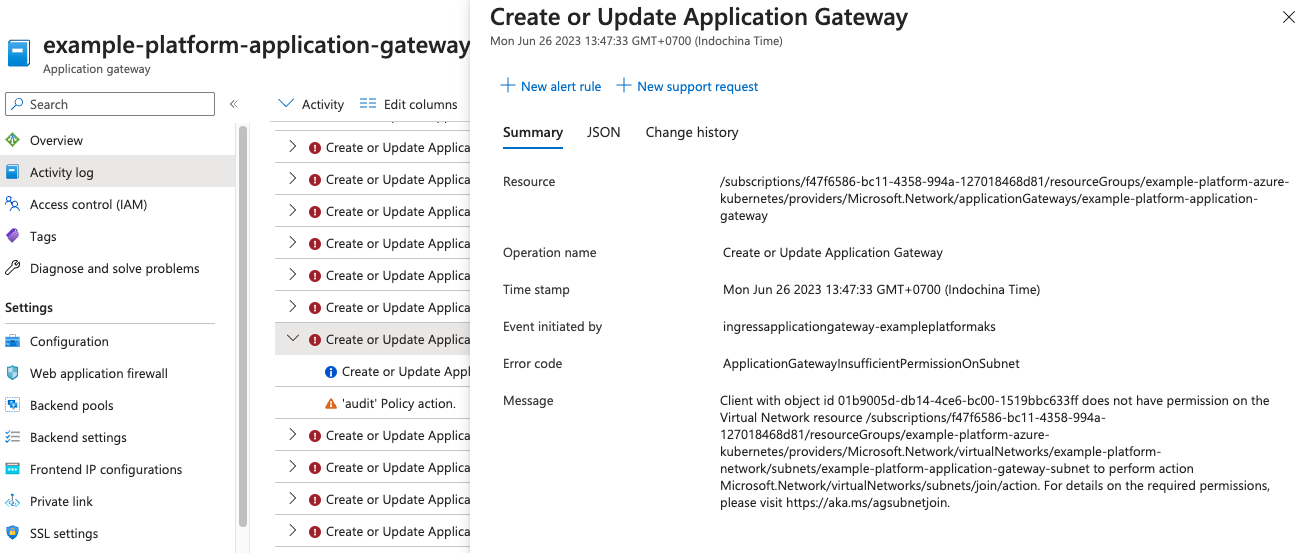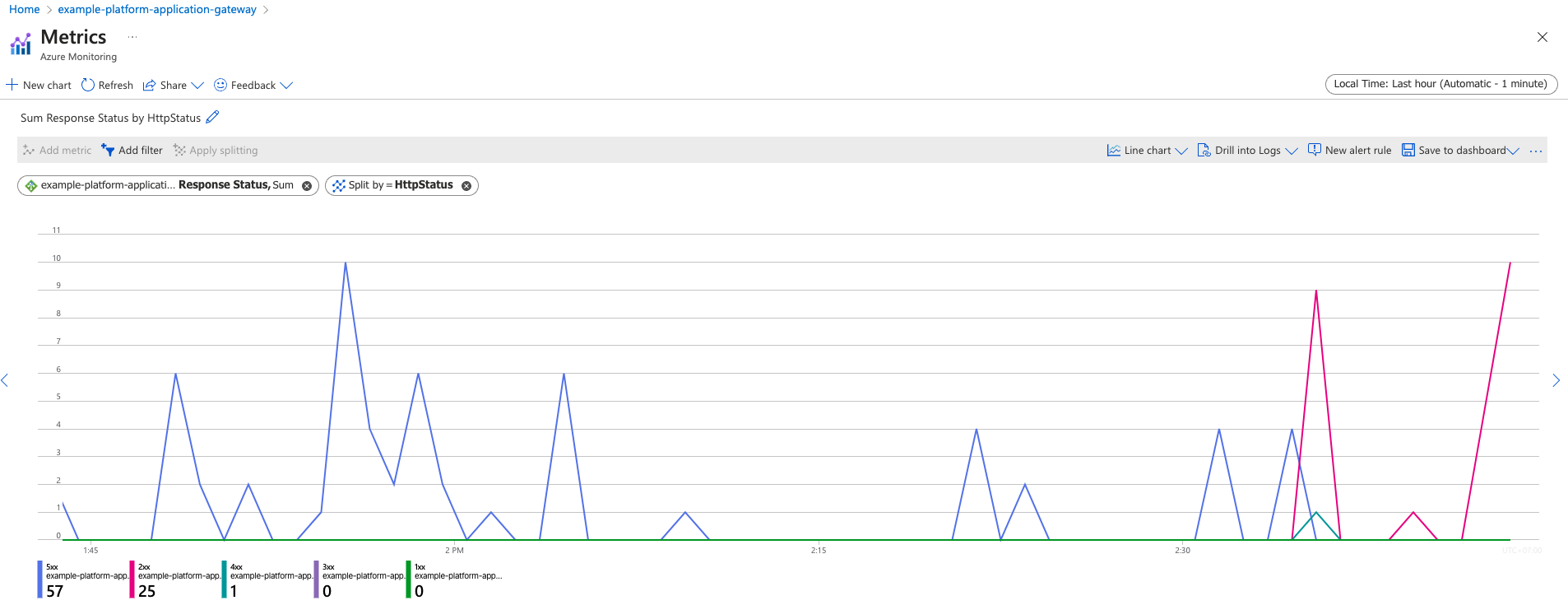แก้ปัญหา Azure Application Gateway อยู่ ๆ ก็เกิด 502 Bad Gateway
เมื่ออาทิตย์ก่อนในบริษัทลูกค้าเกิดปัญหาว่า API ที่ deploy ไว้บน Azure Kubernetes Service (AKS) มันส่ง 502 Bad Gateway กลับมาตลอด ก็มีการหาวิธีแก้แล้วก็ติดต่อหา Microsoft Support จนแก้ได้สำเร็จ เลยขอจดบันทึกไว้ดูหน่อยหากเราต้องมาเป็นคน maintain เองขึ้่นมาวันใดวันหนึ่ง
อธิบาย Architecture ปัจจุบัน

https://learn.microsoft.com/en-us/azure/architecture/example-scenario/aks-agic/aks-agic
Architecture แต่เดิมทีนั้นก็คือ client จะส่ง request เข้ามาผ่าน Azure Application Gateway (AGW) ที่ผูกกับ AKS ไว้ผ่าน Application Gateway Ingress Controller (AGIC) ทั้งหมดจะถูกตีล้อม network ไว้ใน Azure Virtual Network (VNet) ที่มี subnet แยกไว้สำหรับ AKS และ AGW เลย
-
AGW ก็คือ Layer-7 Load Balancer ซึ่งเหมาะสำหรับ AKS เนื่องจากเราไม่รู้ว่าแต่ละ Pod มันถูก assign ด้วย IP อะไรกันแน่ เพื่อให้ client ส่ง request เข้ามาหา AGW ผ่าน internet (internet-facing) เราก็ต้องแปะ public IP ที่ host ไว้ใน Azure ด้วย เพิ่มแต่งด้วยการเอา public DNS ไปแปะเพิ่มอีกทีก็ได้เหมือนกัน โดยเราต้องเพิ่ม role เข้าไปคือ Reader สำหรับอ่านข้อมูลใน resource group
-
AGIC นั้นก็จะตรวจดู AKS ผ่าน Kubernetes API ว่ามันมีการเปลี่ยนแปลง resource configuration ไหม ถ้ามีมันก็จะทำการ update AGW เช่น มีการเพิ่ม service เข้ามาใหม่ชื่อ
foobarพร้อมกับ configuration ว่าถ้า request เข้ามาผ่าน AGW public IP ที่มี path ขึ้นต้นด้วย/foobar(เราเรียก configuration นั้นว่า Ingress) แล้วให้ re-route traffic ไปหา service ภายใน AKS ได้นั่นเองapiVersion: v1 kind: Pod metadata: name: foobar labels: app: foobar spec: containers: - image: "your.container.registry.com/foobar:latest" name: foobar-image ports: - containerPort: 8080 protocol: TCP --- apiVersion: v1 kind: Service metadata: name: foobar spec: selector: app: foobar ports: - protocol: TCP port: 80 targetPort: 8080 --- apiVersion: networking.k8s.io/v1 kind: Ingress metadata: name: foobar annotations: kubernetes.io/ingress.class: azure/application-gateway spec: rules: - http: paths: - path: /foobar/* backend: service: name: foobar port: 80 pathType: Prefix -
หนึ่งในความสามารถของ AKS คือเราสามารถ configure access เข้าไปหา resource ต่าง ๆ ใน Azure ได้ผ่าน role-based access control (RBAC) โดยตอนที่ AKS ถูกสร้างมันจะสร้าง Managed Identity ขึ้นมาตัวนึงที่มันผูกกับ RoleBinding และ ClusterRoleBinding ของ AKS ไว้เรียบร้อยแล้ว ทีนี้เมื่อเราเพิ่ม role เข้าไปใน Managed Identity ตัวนั้นผ่าน Azure มันก็จะไปเห็นผลใน AKS ด้วยเช่นกัน โดยเราต้องเพิ่ม role เข้าไปดังนี้
- Managed Identity Operator สำหรัับผูก Managed Identity ของ AKS เข้ากับ Managed Identity อีกตัวนึงที่เราสร้างเอง โดยความแตกต่างคือ Managed Identity ของ AKS จะเป็น System-assigned เหมาะสำหรับการไปผูกกับ resource ที่ถ้าถูกลบไปแล้วตัว AKS เองก็ควรจะถูกลบด้วย (coupled) ในขณะที่ Managed Identity อีกตัวนึงที่เราสร้างเองจะเป็น User-assgined เหมาะสำหรับการไปผูกกับ resource อื่น ๆ ที่สามารถแยกออกจากกันได้ (decoupled) ตัวอย่างก็จะอยู่ใน bullet ถัด ๆ ไป
- Network Contributor ให้ AKS สามารถเข้าถึง subnet เพื่อ Node pool ของ AKS จะได้ใช้ IP จาก subnet นั้นไป assign เข้า container ใช้ System-assigned Managed Identity เนื่องจากหากขาด subnet ไป ตัว AKS จะไม่สามารถทำ networking ได้เลย
- AcrPull ให้ AKS ไป pull container image จาก Azure Container Registry (ACR) ผ่าน kubelet ที่ทำหน้าที่เป็น processor ที่ใช้ควบคุมการทำงานของ Pod
- Contributor เพื่อผูก AGW เข้ากับ AKS ใช้ User-assigned Managed Identity เพราะถ้าขาด AGW ไป ตัว AKS ก็ยังทำงานของมันได้แค่ client จาก internet ข้างนอกจะเชื่อมเข้ามาใน AKS ไม่ได้นั่นเอง
- Reader สำหรับอ่านข้อมูลใน resource group ใช้ User-assigned Managed Identity เพราะถ้าขาดไปตัว AKS ก็ยังทำงานของมันได้แค่ต่อกับ Azure resource อื่น ๆ ข้างนอกไม่ได้
อยู่ดี ๆ ก็งานเข้า
เกิดปัญหาว่า API ที่ deploy ไว้บน AKS มันส่ง 502 Bad Gateway กลับมาตลอดถึงแม้ว่าตัว application จะยัง healthy ก็ตาม ระบบเกิด downtime ขึ้น พอตัวเราเองลอง deploy AKS ของตัวเองใน subscription ตัวเองก็พบว่าเกิดอาการเดียวกันเลย ณ ตอนนั้นทีมลูกค้าเดาว่างี้มันน่าจะต้องเป็นปัญหาที่ AGIC พอเข้าไป restart และ clear event ของ AGIC ก็ไม่ได้แก้ปัญหา ก็เหลืออยู่แค่อย่างเดียวคือ AGW
พอเข้าไปดู AGW monitoring ก็เห็นจำนวน failed request เยอะมาก ๆ เลยต้องไปดู Activity log ซึ่งเป็นสิ่งที่ช่วยชีวิตไว้ได้จริง ๆ เพราะเราได้เห็น error แล้วว่า AGW มันพังเพราะขาด permission ตามรูปเลย

แสดงว่าต้นเหตุคือ AGW มันขาด permission Microsoft.Network/virtualNetworks/subnets/join/action ในการเข้าไปจัดการ subnet ทีนี้เราเข้าไปอ่าน documentation ของ Microsoft ก็พบว่า
If the virtual network Application Gateway is deployed into doesn’t reside in the same resource group as the AKS nodes, please ensure the identity used by AGIC has the Microsoft.Network/virtualNetworks/subnets/join/action permission delegated to the subnet Application Gateway is deployed into. If a custom role is not defined with this permission, you may use the built-in Network Contributor role, which contains the Microsoft.Network/virtualNetworks/subnets/join/action permission.
ซึ่งก็เข้าเงื่อนไขของเราพอดีเนื่องจาก VNet ของ AGW ไม่ได้อยู่ใน resource group เดียวกันกับ Node ของ AKS
วิธีแก้
ก็ตาม documentation ไปเลยคือเราก็ไปเพิ่ม role Network Contributor ขึ้นมาเพื่อเชื่อม subnet เข้ากับ AGW ผ่าน User-assigned Managed Identity ของ AGW เอง เนื่องจาก AGIC ใช้ identity ตัวนี้ในการ manage subnet นั่นเอง ตัวอย่าง code ข้างล่างคือระบบของเราใช้ Terraform เป็น Infrastructure-as-a-Code เลยมี code ตัวอย่างให้ดู
resource "azurerm_role_assignment" "aks_agic_network_contributor" {
scope = azurerm_subnet.application_gateway_subnet.id
role_definition_name = "Network Contributor"
principal_id = azurerm_kubernetes_cluster.aks.ingress_application_gateway[0].ingress_application_gateway_identity[0].object_id
}
หลังจากเพิ่ม role assignment เข้าไปแล้วพบว่าตอนนี้ Activity log ไม่มี error แล้ว นอกจากนั้น API กลับมา response เป็น 2xx แล้วตามรูป

หลังจากแก้ปัญหาไปผู้คนก็สงสัยกันว่าทำไมแต่ก่อนไม่เห็นต้องเพิ่ม role นี้เลยมันก็ใช้ได้นิ จนทีหลังมาพบว่า Microsoft เพิ่งทำการ update สด ๆ ร้อน ๆ เข้าไปอ่านใน GitHub discussion ใน commit ของ documentation ได้
ถอดบทเรียน
จากปัญหาที่เกิดขึ้น เราได้เรียนรู้สิ่งต่าง ๆ ต่อไปนี้
- ระบบ Kubernetes cluster ตามที่ได้กล่าวไว้ในส่วนของหัวข้อ Architecture
- ควรหมั่น monitor Activity log และ Advisor ใน Azure portal หรือใช้ Azure Service Health นอกจากจะเป็นเบาะแสที่ดีในการค้นหาต้นเหตุแล้ว ยังเอาไว้เรียนรู้ทำตาม best practice ของ Azure ได้อีกด้วย
- ควรหมั่นติดตามการ update ของ Microsoft ผ่านช่องทาง email notification และ toast ใน Azure portal (เพิ่งรู้ว่ากรณีนี้ทาง Microsoft เค้าส่ง email ไปหา subscription owner แล้วด้วย)